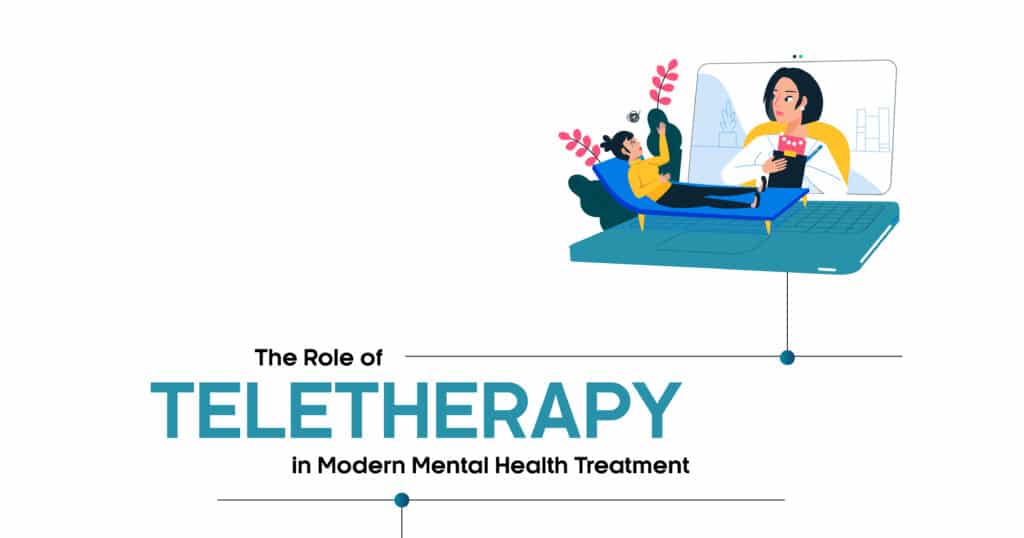In today’s fast-paced world, where convenience and accessibility are paramount, teletherapy has emerged as a game-changer in modern psychiatry and mental health treatment. Whether it’s the flexibility of scheduling, the comfort of attending sessions from home, or the ability to connect with a mental health professional across the country, teletherapy has revolutionized how we approach care for various mental health disorders.
Essential Takeaways
- Teletherapy Offers Convenience and Accessibility: It provides flexible, private access to mental health care from anywhere, making it a valuable option for individuals facing mental health issues.
- Challenges Exist but Are Manageable: Proper planning and communication can address technological and privacy concerns, ensuring a positive teletherapy experience.
- The Future is Promising: Innovations and evolving regulations will continue to shape teletherapy, enhancing its effectiveness and expanding its reach to include treatment plans for complex conditions like bipolar disorder and severe depression.
In this comprehensive guide, we’ll explore the role of teletherapy, its benefits, challenges, and future potential, providing a thorough understanding of how this innovative approach is reshaping behavioral health care.
What is Teletherapy?
Definition and Overview
Teletherapy, also known as online therapy, virtual therapy, or e-therapy, refers to the delivery of therapeutic services through digital platforms. Instead of visiting a primary care provider or a psychiatric hospital in person, individuals can engage in therapy sessions via video calls, phone calls, or messaging apps. This method leverages technology to support mental health, making therapy more accessible to a wider audience, including those with chronic pain or substance use disorders.
How Teletherapy Works
Teletherapy sessions are conducted using a variety of technologies, each offering different advantages:

- Video Conferencing: This is the most common form of teletherapy. Platforms like Zoom, Skype, and specialized teletherapy apps allow real-time video interactions between therapists and clients. This setup replicates the face-to-face experience, enabling psychological treatment crucial for effective therapy, particularly for mood disorders and psychotic disorders.
- Phone Calls: Phone-based therapy offers a convenient alternative for those who prefer or require voice communication. This can be particularly useful for individuals with limited internet access or those who feel more comfortable with a voice-only interaction, such as those dealing with anxiety disorders.
- Text and Email Therapy: Asynchronous communication through text or email allows clients to share their thoughts and receive feedback at their convenience. This can be beneficial for those who need flexible scheduling or prefer written communication, especially for managing panic disorder or obsessive-compulsive disorder.
Benefits of Teletherapy
Accessibility and Convenience
One of the most significant advantages of teletherapy is its accessibility. Here’s how it enhances convenience:
- Geographic Flexibility: Teletherapy eliminates the need to travel, allowing individuals to access therapy from any location. This is especially beneficial for those living in remote or underserved areas where community mental health services might be limited.
- Flexible Scheduling: Teletherapy often offers more flexible scheduling options than traditional in-person sessions. Therapists may provide evening or weekend appointments, making it easier for clients with busy or irregular schedules to find a suitable time, especially those juggling physical health conditions and mental conditions.
- Comfort of Home: Attending therapy sessions from your home can create a more relaxed environment. This setting can reduce symptoms of depression and anxiety, making it easier to open up during sessions.
Reduced Stigma and Increased Privacy
Teletherapy can also help reduce the stigma associated with seeking mental health support:
- Anonymity: Being in a private, familiar space can make it easier for individuals to discuss sensitive issues without fear of judgment or public exposure. This anonymity can encourage more people to seek help who might otherwise avoid it, especially those dealing with post-traumatic stress disorder.
- Reduced Travel Anxiety: For many, traveling to a therapist’s office can be a source of stress. Teletherapy removes this barrier, making it easier for individuals to attend their sessions consistently and benefit from evidence‐based psychotherapy.
Enhanced Continuity of Care
Teletherapy supports continuous care by offering:
- Consistency: With teletherapy, maintaining regular sessions becomes more manageable, even when life circumstances change. Individuals can continue their therapy without disruption, whether moving to a new city or dealing with unpredictable schedules. This is crucial for ongoing psychological therapy or cognitive control training for conditions like attention deficit disorders.

- Emergency Access: Teletherapy can provide immediate support in urgent situations or crises. Clients can quickly reach their therapist or access crisis resources without needing in-person appointments.
Challenges and Considerations
Technological Barriers
While teletherapy offers many benefits, it also comes with its own set of challenges:
- Connectivity Issues: Reliable internet access is essential for effective teletherapy. Poor connections or technical glitches can disrupt sessions and hinder communication. It’s important for both clients and therapists to ensure they have a stable internet connection and are familiar with the technology being used.
- Platform Compatibility: Different teletherapy platforms offer various features and user experiences. Clients and therapists may need to navigate learning curves associated with new technology. Choosing a user-friendly platform that meets privacy and security standards is crucial for a smooth experience, especially when discussing psychiatric medications or alternative therapies.
Privacy and Security Concerns
Ensuring privacy and security in teletherapy is paramount:
- Data Protection: Teletherapy platforms must adhere to privacy regulations, such as HIPAA in the United States, to protect client data. Secure communication channels and encryption are essential to safeguard sensitive information, especially when discussing conditions like borderline personality disorder or anorexia nervosa.
- Confidentiality: Maintaining confidentiality in a virtual setting requires vigilance. Both clients and therapists should ensure their sessions occur in private spaces, and therapists must use secure platforms to prevent unauthorized access.
Effectiveness Compared to In-Person Therapy
The effectiveness of teletherapy compared to traditional in-person therapy is a common concern:
- Research Findings: Studies have shown that teletherapy can be as effective as in-person therapy for many individuals. Research indicates that teletherapy offers comparable outcomes for various mental health conditions, including anxiety disorders, depressive disorders, and substance abuse.
- Therapeutic Alliance: Building a strong therapeutic relationship is crucial for successful therapy. While some may find it takes time to establish rapport in a virtual setting, many clients report positive experiences and effective therapeutic alliances through teletherapy.
The Future of Teletherapy
Innovations and Advancements
The future of teletherapy is bright, with several exciting innovations on the horizon:
- AI and Chatbots: Artificial intelligence (AI) and chatbots are being integrated into mental health care to provide initial assessments and support. These tools can offer preliminary guidance and resources, complementing traditional therapy, particularly for adults with mood disorders or psychotic disorders.
- Virtual Reality (VR): Virtual reality is being explored for immersive therapeutic experiences. VR can simulate environments and scenarios to help individuals confront fears, practice mindfulness, or engage in interactive therapy. This can be particularly effective for exposure therapy in treating post-traumatic stress disorder.
- Magnetic Stimulation: Brain stimulation therapies like vagus nerve stimulation and electroconvulsive therapy are being explored as complementary treatments alongside teletherapy for conditions like extreme mood disorders.
Integration with Traditional Therapy
Teletherapy is expected to complement, rather than replace, traditional therapy:
- Hybrid Models: Combining in-person and virtual sessions offers a balanced approach to therapy. Clients can benefit from the flexibility of teletherapy while maintaining the option for face-to-face interactions when needed, particularly for types of psychotherapy like behavioral therapy or Cognitive behaviour therapy.
- Enhanced Access: Teletherapy expands access to mental health care, particularly in areas where traditional services may be limited. It provides a bridge to therapy for underserved populations and those with mobility issues, including those requiring psychiatric treatments.
Policy and Regulation Developments
As teletherapy continues to grow, policy and regulation will evolve:
- Insurance Coverage: Increasing acceptance of teletherapy by insurance providers is making it more accessible. Many health plans now cover teletherapy, making it a viable option for a broader range of individuals, including those covered by Care Health Insurance.
- Licensing and Regulations: Evolving regulations will impact how teletherapy is delivered across state and national borders. Ensuring compliance with licensing requirements and regulations is crucial for the continued growth and effectiveness of teletherapy.
Practical Tips for Engaging in Teletherapy
Preparing for Your Teletherapy Session
To ensure a successful teletherapy experience:
- Choose a Private Space: Find a quiet and private area for your sessions to minimize distractions and maintain confidentiality. A comfortable and well-lit space can also enhance the quality of the interaction, particularly when discussing mental disorders or psychiatric diagnosis.
- Test Technology: Before your session, check your internet connection and familiarize yourself with the teletherapy platform. Ensure your camera and microphone are working properly to facilitate smooth communication.
Maximizing the Effectiveness of Teletherapy

To get the most out of teletherapy:
- Be Open and Honest: Approach your teletherapy sessions with the same openness and honesty as you would in person. Share your thoughts and feelings freely to ensure effective therapy.
- Set Goals: Work with your therapist to set clear goals for your teletherapy sessions. Having a roadmap can help you stay focused and motivated, particularly when managing chronic mental disorders or comorbid disorders.
Conclusion
Teletherapy is reshaping mental health care, offering unprecedented accessibility, convenience, and privacy. While challenges remain, the future of teletherapy is bright, with innovations and evolving policies set to enhance its effectiveness further. Whether you’re dealing with anxiety, depression, or any other mental health concern, teletherapy provides a viable and effective option to support your mental well-being.







